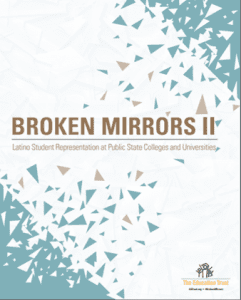 Last month, as we welcomed the start of National Hispanic Heritage Month, The Education Trust released Broken Mirrors II: Latino Student Representation at Public State Colleges and Universities. The report takes a closer look at how well Latino residents are represented in higher education by analyzing census and federal higher education data. Though nearly one in five Americans is Latino and college enrollment rates of Latinos is growing, Latino students are still underrepresented on college campuses.
Last month, as we welcomed the start of National Hispanic Heritage Month, The Education Trust released Broken Mirrors II: Latino Student Representation at Public State Colleges and Universities. The report takes a closer look at how well Latino residents are represented in higher education by analyzing census and federal higher education data. Though nearly one in five Americans is Latino and college enrollment rates of Latinos is growing, Latino students are still underrepresented on college campuses.
This report is the second report in the Broken Mirrors series focusing on the advancement of education equity and justice for students of color and students from low-income families. Broken Mirrors is a reminder about the disparities we continue to see because of the color of someone’s skin or the zip code they were born in.
“According to the report, the high-level findings include:
- Latino students are underrepresented at public colleges and universities, especially at community and technical colleges, in the vast majority of states.
- The states with the largest Latino populations fail to provide Latino students with the same access to selective public four-year institutions as their White Peers.
- Latinos are underrepresented among associate and bachelor’s degree earners in 44 states examined.
- A smaller share of Latino graduates received a bachelor’s degree compared to their White peers in most states.
What can we do immediately to level the playing field and ensure everyone has a fair opportunity to access and succeed in higher education? Ed Trust outlines four steps state and institutional leaders can take now, including establishing race and ethnicity goals within larger statewide college degree attainment goals and rewarding colleges who are enrolling and graduating students of color.”
The Center applauds the efforts of Ed Trust to pull back the layers of what college enrollment truly looks like in the United States. It’s not enough to say we need 60 percent of the adult population to earn a degree or credential by the year 2025. Let’s use the Broken Mirrors series to have the difficult conversations with partners, funders, and community leaders. We need to focus our efforts to support black and Latino students in our communities.
Not sure how to start the conversation? Ed Trust has you covered there as well. They provide a list of questions state and higher education leaders and advocates should be asking. You can also play around with a State Equity Report Card web tool to how your state stacks up.
See the full report, suggested questions, and to dive into State Equity Report cards here.
